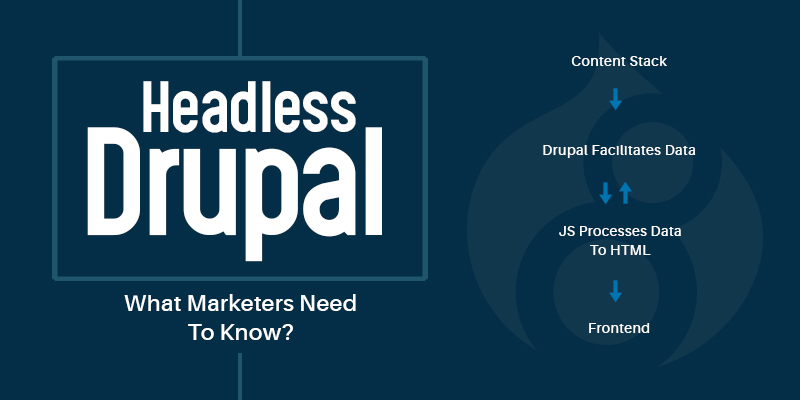Headless Drupal: What Marketers Need To Know

Decoupled or Headless content management systems are growing popular these days. The major reason for this is that such CMSs allow users to write the content once and access the same on various devices. The same trend has turned out to be a recent hot topic in the Drupal community. Before getting to know, what the community is all talking about, let’s get a quick insight into Headless Drupal.
What Is Headless CMS?
A headless CMS is the one which has the ability to store, maintain, and edit content but does not deliver the content. It is termed headless as it chops off the display part of the CMS. Such CMSs deliver content through an API anywhere and on any device, and this is commonly referred to as API first. This approach begins with RESTful API that acts as a communication channel between the headless CMS, user devices and the backend.
Similar to Software as a Service (Saas), the headless CMS works as Content as a Service (CaaS). Drupal functions as a host that manages the content and offers the same as a service, making it easy to access content on various apps and sites.
If you have a Drupal website, you definitely need to know about headless Drupal. When it comes to normal installations, Drupal provides ways to store, administer and display content. Whereas in headless Drupal, the display functionality is replaced with an API to the data which can be accessed by a different framework. Drupal 8 comes with RESTful Web Services module in the core which in return comes with many powerful modules such as Views and Paragraphs.
Headless Drupal To Marketers
A headless CMS promises a flexible, responsive, and engaging user experience. With the introduction of new devices every now and then, the greatest challenge faced by marketers is to make the content available on these devices. With a headless CMS, this challenge can easily be handled.
Yet another major reason for marketers to choose headless Drupal is that they function faster than normal Drupal. This happens because the logic is on the front-end interface, which allows to streamline the back-end CMS. The back-and-forth interaction happens in real-time in the browser.
The highly responsive and fast websites ensure that the user engagement quotient is kept high always, thereby paving a way for you to get closer to the business goal.
Why All The Marketers Don’t Choose Headless Drupal?
Drupal being one of the most preferred content management systems across various industries has a lot of functionalities that the users love in the CMS. Going for a headless CMS can bypass the value of content delivery. A lot of functionalities are lost and may have to be recreated on the front end to maintain a good user experience level. This results in higher costs and increase in development time.
Another major point to be checked by marketers is SEO. The headless Drupal results in the loss of standard SEO functionality and all the pain and strain you put for years together on the SEO of your site will go in vain.
In addition to all this, code maintenance is a major challenge. If you face any issues with your site, then you will need the support of the IT team to resolve them. Security concerns? You’re largely on your own.
Drupal SEO
If you are looking for a CMS that can ensure that the website is highly responsive, fast and user engaging, you may consider to choose headless Drupal for your website. But, if you are a website owner who pays a lot of attention on the features, functionality and security, it is good for you to think twice before you make the decision.
Before you take a decision on headless Drupal, be sure to invest additional time and cost for Drupal SEO development. Our experienced Drupal developers at DrupalPartners can work with your development team to ensure that the right functionality is available in the finished product.
